環境保護局(DOC)は、ダニーデンのビジターセンターが6月末までに閉鎖されると発表しました。2015年にオープンしたこのセンターは、ダニーデン市議会のiSiteの隣にあります。ただし、閉鎖によって人員が削減されることはありません。
DOC南島南島運営部長のアーロン・フレミング氏は、センターのリース期限が近づいているため、同省がどのようにしてこの地域に最善のサービスを提供できるかを考え直す時期が来たと説明した。訪問者の習慣は変化しつつあり、DOCは財政的に持続可能な方法で適応する必要があると指摘しました。
フレミング氏は、野生動物や遊歩道、小屋に関する情報やサービスを探すために、人々はさまざまな方法でDOCと交流していると言いました。彼は、主要都市部の人々が必要とする屋外の訪問者情報とサービスを最も効果的に提供する方法について、これまでとは違う考え方をする必要があると強調しました。
ダニーデン市は野生動物のホットスポットとして知られています。DOCは長年にわたり、ダニーデン市議会と協力してワイルドライフ・ケア・コードを策定してきました。このイニシアチブは引き続きiSiteで実施され、DOCは他の方法で地域社会における野生生物教育に焦点を当てる予定です。
フレミング氏は、今後スタッフはアドボカシーと保護に専念するようになり、スタッフの数が減ることはないと確信しました。さらに、DOCはオタゴ沿岸地域でのプレゼンスを維持し、野生空間、遺産、レクリエーション施設を安全かつ楽しく利用する方法についての情報、助言、教育を提供していくと付け加えました。
ダニーデン市議会のiSiteは、野生動物保護活動を含む訪問者情報を引き続き共有していきます。この地域の野生動物、遊歩道、小屋に関する情報は、DOCのウェブサイトでもご覧いただけます。





























































